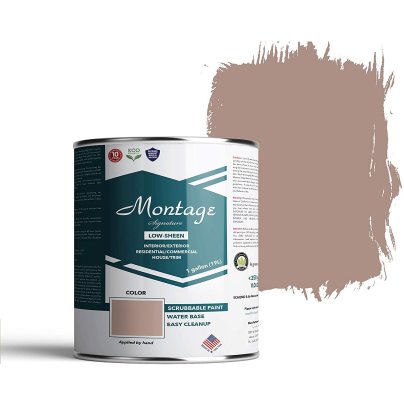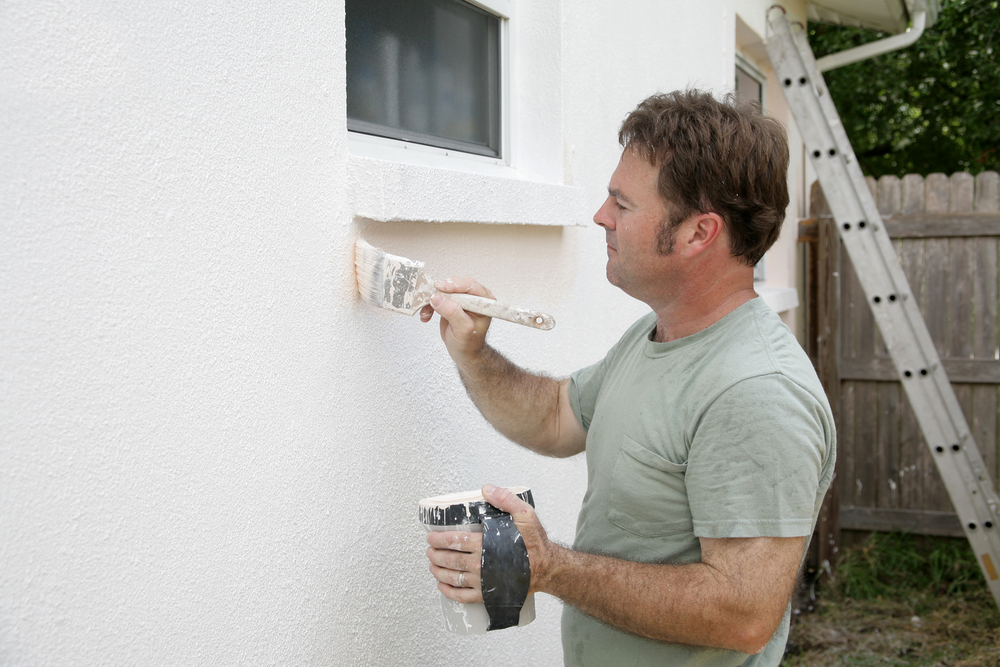
We may earn revenue from the products available on this page and participate in affiliate programs. Learn More ›
Stucco—a plaster material often used to coat walls, mold architectural decorations, and texturize drywall—is a great option for exteriors because it has a high resistance to UV radiation and precipitation. Over time, however, the surface can start to show stains, hairline cracks, and chipping, requiring repair with a stucco filler. Once the damage is corrected, it’s ready for primer and the right exterior paint to update its appearance.
The three best types of exterior paint for stucco are elastomeric, masonry, and acrylic. While other paint formulas may stick to stucco when applied, they may be susceptible to bubbling, chipping, and peeling. Use this guide to learn more about the best paints for stucco and be introduced to top products that will help you achieve good-looking, durable results.
- BEST OVERALL: Prestige Exterior Paint and Primer in One
- RUNNER-UP: INSL-X SXA11009A-01 Stix Acrylic Waterborne Primer
- BEST BANG FOR THE BUCK: Montage Signature Interior/Exterior Eco-Friendly
- BEST ACRYLIC PAINT: Microblend Exterior Paint and Primer
- BEST ELASTOMERIC: AMES BWRF5 Water Base High Strength Elastomeric

What to Consider When Choosing the Best Exterior Paint for Stucco
In addition to choosing the right formulation, you’ll want an exterior paint with high durability, weather resistance, and color longevity for a stucco house. Also keep in mind how much area the paint can cover, its dry time, and the level of volatile organic compounds (VOCs).
Type
These are the three types of paint that work best on stucco house including masonry, acrylic, and elastomeric—each with pros and cons.
- Masonry paints, made to bond with masonry substrates, cinder blocks, concrete, and stucco, is very durable and has a high level of moisture and mildew resistance. However, masonry paints come in a limited number of colors and have lower coverage than acrylic paints.
- Acrylic paint has the highest permeability of the three types, meaning that it can penetrate further into the stucco material. This allows moisture to escape from the stucco instead of forming unsightly bubbles under the paint. Acrylic paint is an affordable option with great color longevity and durability. It comes in a wide range of colors and finishes and typically dries faster than either masonry or elastomeric paint but doesn’t bond to stucco as well as the alternatives. It also lacks the high level of waterproofing provided by elastomeric paint.
- Elastomeric paint is essentially a rubber paint that goes on in a liquid form and dries as a solid layer of rubber. It is the best option for water resistance, and its thick formula is one of the few options that can be used to conceal hairline cracks in stucco surfaces. It won’t provide vibrant color or a glossy appearance, however, and it can take up to 72 hours to fully cure. Elastomeric paint may have issues bonding to stucco that already has several layers of paint because its weight can cause the old paint to pull away from the wall.
Durability
The durability of an exterior paint product on a stucco house can be influenced by its formula, viscosity, finish, and the number of coats that are applied.
- Formula is a primary determinant of a paint’s durability. Acrylic paints are the most breathable of the three formulas suitable for stucco, with high resistance to chipping, peeling, bubbling, and fading. Though masonry paints are designed to bond to masonry surfaces such as stucco, they’re not as breathable or flexible as acrylic paints, so they are more susceptible to cracking and peeling. Elastomeric paints have a high level of durability and resistance to moisture.
- Viscosity is a good indicator of paint durability. In general, the thicker the viscosity, the more durable the paint will be after it fully cures. Viscosity is also a good indicator for coverage, with thicker paints capable of concealing small cracks and chips.
- There are four common finishes for exterior paint: flat, satin, semi-gloss, and gloss. Flat is most frequently used for stucco because it helps to conceal small imperfections that a glossier finish would highlight.
- On one hand, the more coats of paint applied, the more durable the results. However, paint has weight and with each coat, the cumulative weight increases—ultimately, it can reach a point that the first coat no longer has the strength to adhere. Should this occur, the paint will begin to peel away from the stucco and can damage the surface. While this scenario is rare, the weight of paint should be considered, especially with elastomeric paint, which tends to be the heaviest of the three types. If dealing with a wall that has many layers of paint, it may be wise to remove some layers with paint stripper before repainting.
Weather Resistance
Exterior paint is specifically designed to stand up to the elements—rain and snow, UV rays, and fluctuating temperatures—but there are levels of weather resistance among these paints.
Elastomeric paint is the most weather-resistant option. The rubber in the formula seals out moisture, and the thick viscosity protects from damaging UV radiation. To help ensure that elastomeric paint bonds to stucco, use an exterior primer.
Masonry paint has a strong adhesion to stucco and can form a watertight seal. However, it’s vulnerable to UV radiation, which can cause the paint to crack. Acrylic paint is made for deep permeation and breathability, features that allow it to seal the stucco, protecting it from water and UV damage. Acrylic paint can also expand and contract with rapid temperature fluctuations, resisting bubbling, peeling, and cracking.
Climate Suitability
Choose an exterior paint for stucco that’s formulated for the climate in your region. Some exterior paints are specifically made to dry and cure in temperatures as low as 35 degrees Fahrenheit. Humidity can increase dry time and affect the final result, but fortunately, there are exterior paints formulated for use in humid climates. Check product information on the label or manufacturer’s website, or ask the seller if you are unsure if the paint has this feature.
VOCs
Volatile organic compounds (VOCs) are harmful chemicals commonly found in exterior paint products. Potential effects of VOCs include irritation to the airways, headaches, nausea, and even damage to the liver, kidneys, or central nervous system. Some people consider the harmful effects of VOCs to be less of an issue with exterior paints because they are used outside so fumes can escape, while others prefer to keep VOC exposure to a minimum regardless.
Standard VOC concentrations in paint are capped at a maximum of 250 grams per liter (g/L) for flat finishes and 380 g/L for other finishes. However, low-VOC and zero-VOC products are also available. Low-VOC paint products are required to have less than 50 g/L, while zero-VOC products can actually contain VOCs as long as the concentration is 5 g/L or less. Though users should keep in mind that the low-VOC or zero-VOC label applies only to the base paint. Any added colorant can increase the VOC concentration.
Lasting Color
When it comes to color longevity, acrylic paint is the best choice because it permeates the deepest into the stucco. Elastomeric and masonry paints are great for sealing out moisture and bonding to stucco surfaces but less effective at maintaining clear, bright colors because they don’t permeate as deeply.
Also keep in mind that the specific color of the paint itself can affect its resistance to direct sunlight. Darker colors begin to noticeably fade before lighter shades. If you want to paint your home’s exterior in a dark hue, consider a product that contains titanium dioxide, an additive that helps resist color fading. If older stucco is noticeably dirty, you may wish to purchase an exterior paint product that has a high-hiding formula to help conceal stains.
Coverage and Dry Time
Coverage and dry time depend on specific formulations. Check the product information and the manufacturer’s recommendations for use to determine total paint coverage per gallon and how long it takes for a product to fully cure.
Acrylic paints have higher coverage than masonry or elastomeric paint, typically covering about 300 to 400 square feet per gallon of paint. The other two types cover only about 75 to 125 feet per gallon on average.
Both acrylic and masonry paint have a relatively quick cure time of about 24 hours. Elastomeric paint can take up to 72 hours to fully cure. Also keep in mind that high humidity and low temperatures can increase cure time.
Surface Prep and Application
When painting stucco or any material, it’s important to prepare the surface to get the best results, and exterior stucco walls are no exception. Patch any cracks or holes, then sand the patches. Also sand any peeling, bubbling, and chipping paint. Once repairs are made, wash the stucco walls with a power washer on a low setting to remove dirt and debris. Cleaning helps create a strong adhesion between the wall and the paint.
If the product you choose isn’t a primer-and-paint combination, apply an exterior primer before painting stucco. While exterior paint can be applied with a brush or roller, a paint sprayer will provide better dispersal—important for getting into the divots and creases common on stucco walls.
Our Top Picks
The top picks described here were selected based on the above criteria and considerations, with significant attention given to efficacy and overall value. These products are all considered among the best exterior paint for stucco.
Best Overall
Prestige Exterior Paint and Primer In One
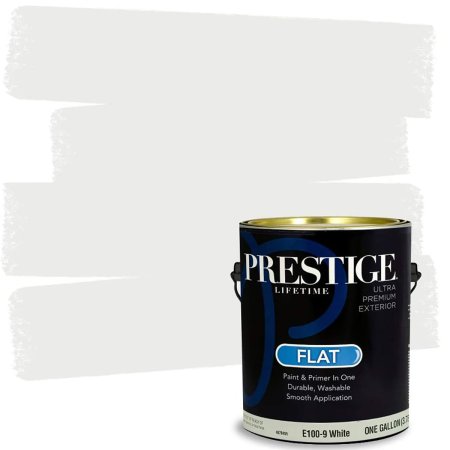
Pros
Cons
Product Specs
- Type: Acrylic
- Colors: 317
- Finishes: Flat, satin, and semi-gloss
- Coverage Area: 400 square feet
- Drying Time: 24 hours
For a long-lasting improvement on old or faded stucco, consider this quality PRESTIGE exterior acrylic paint. It comes in 317 color options and a choice of a flat, satin, or semi-gloss finish. The paint has a coverage of up to 400 square feet per gallon, and the high-hiding formula helps to conceal stains in old or worn stucco.
It takes about 2 hours to dry to the touch and 24 hours to fully cure (high humidity and low temperatures can increase the drying time). This low-VOC acrylic paint-and-primer product is resistant to moisture, mold, fungus, mildew, bubbling, peeling, cracking, and UV radiation—and its high durability helps to preserve color.
Get the PRESTIGE Paints exterior stucco paint on Amazon.
Runner-up
INSL-X SXA11009A-01 Stix Acrylic Waterborne Primer

Pros
Cons
Product Specs
- Type: Acrylic
- Colors: 1
- Finish: Flat
- Coverage Area: 300 to 400 square feet
- Drying Time: 72 hours
Those who may want to paint their home’s stucco exterior in chilly or humid weather may be impressed with this INSL-X product. The versatile acrylic paint can be used on a wide variety of challenging surfaces, including concrete, stucco, cement, aluminum, and even ceramic tiles. Its low-VOC formula can fully cure quite well in high humidity environments and temperatures as low as 35 degrees Fahrenheit.
A gallon of this interior/exterior white paint can cover between 300 and 400 square feet, depending on the porosity of the material. It dries to the touch in about 2 hours. A second coat can be added after 3 to 4 hours, but since it can take up to 72 hours to fully cure, users are advised to paint during a long stretch of decent weather for best results on exterior stucco.
Get the INSL-X Stix acrylic paint on Amazon and at Walmart.
Best Bang for the Buck
Montage Signature Interior/Exterior Eco-Friendly

Pros
Cons
Product Specs
- Type: Acrylic
- Colors: 18
- Finishes: Low-sheen and semi-gloss
- Coverage Area: 300 square feet
- Drying Time: 24 hours
For a budget-friendly interior/exterior acrylic paint with a range of colors and finishes, check out this Montage Signature product. There are 18 color options (5-by-8-inch chip card samples are available) and a choice between a low-sheen or semi-gloss finish. For extra economy, consider the 5-gallon bucket size.
This paint goes on easily with a roller, brush, or sprayer and takes about 1 hour to dry to the touch and 24 hours to fully cure. The acrylic paint has a coverage of about 300 square feet per gallon (coverage depends on the color of the previous paint and whether a primer is applied first). Note that this is not a low-VOC option, so it should be used only in a well-ventilated space.
Get the Montage Signature paint on Amazon and at Walmart.
Best Acrylic Paint
Microblend Exterior Paint and Primer
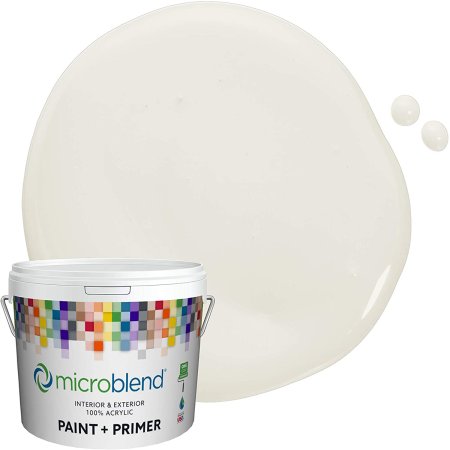
Pros
Cons
Product Specs
- Type: Acrylic
- Colors: 13
- Finishes: Eggshell, flat, gloss, satin, and semi-gloss
- Coverage Area: 300 to 400 square feet
- Drying Time: 24 hours
This Microblend exterior paint and primer is a long-lasting option to update the appearance of exterior stucco surfaces. Its 100 percent acrylic formula is resistant to sun, wind, rain, sleet, and snow, as well as bubbling, peeling, and chipping. The paint comes in several sizes ranging from a 4-ounce sample to a 5-gallon bucket, with a coverage of 300 to 400 square feet per gallon.
The low-VOC paint comes in 13 light neutral colors and eggshell, flat, gloss, satin, and semi-gloss finishes. Its thick consistency can cover old exterior paint in just one coat unless the previous paint is significantly darker. This paint takes about 24 hours to fully cure, and it also contains stain blockers and rust inhibitors to help extend the stucco’s good looks.
Get the Microblend Exterior paint at Amazon, Sears, and Walmart.
Best Elastomeric
AMES BWRF5 Water Base High Strength Elastomeric
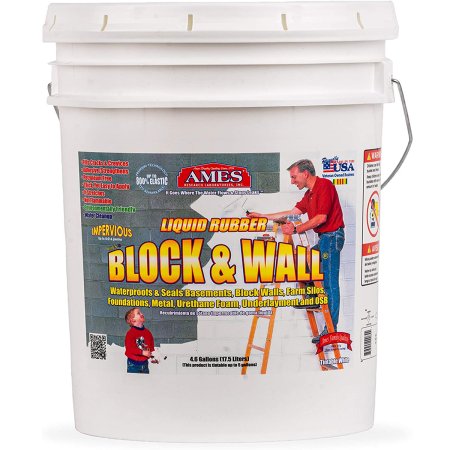
Pros
Cons
Product Specs
- Type: Elastomeric
- Colors: 1
- Finishes: Flat
- Coverage Area: 100 square feet
- Drying Time: 24 hours
The elastomeric formula of this AMES paint is highly effective at protecting against moisture, making it a great choice for locations that regularly receive heavy rain, sleet, or snow. The paint is highly durable, with resistances to fungus, mold, mildew, bubbling, peeling, chipping, and fading. It’s sold in a 5-gallon bucket and covers about 100 square feet per gallon.
The paint’s thick consistency allows it to fill hairline cracks and also makes it suitable for a range of materials besides stucco, including metal, wood, concrete, and stone. It is a nontoxic, low-odor product that is dry to the touch within about 2 hours and takes about 24 hours to fully cure. It’s available in white only but can be tinted with colorant, although this may add toxicity.
Get the AMES Elastomeric paint at Amazon, The Home Depot, and Walmart.
Our Verdict
If your exterior stucco needs a refresh, we recommend the acrylic PRESTIGE Paints exterior stucco paint with its vast number of colorways and finishes and durable, low-VOC formula. Alternatively, for an extremely durable paint option, the AMES elastomeric paint sticks to multiple exterior surfaces and protects against fungus, mold, mildew, bubbling, peeling, chipping, and fading while filling cracks upon application.
How We Chose the Best Exterior Paints for Stucco
We researched the most sought-after paints for stucco exteriors in their respective categories and discovered that the best options are determined by their type, colors and finishes, coverage area, drying time, compatibility with multiple surfaces, and other special features included by top brands.
While searching for the best paints for stucco exteriors, we found that the acrylic and elastomeric options were the most common among users. While select options included in our list come in 1 color and finish, many options come in 13 to 317 colorways and eggshell, flat, gloss, satin, low-sheen, and semi-gloss finishes. Plus, depending on your chosen paint, these options cover 100 to 400 square feet of exterior surfaces like stucco, cement, concrete, metals, ceramic, stone, and wood.
Some of these paints for stucco exteriors are capable of drying to the touch in just a few hours and fully cure over 72 hours. Finally, most of the paints listed are low-VOC, resist most common weather conditions and wear-and-tear, and block stains with just one coat.
FAQs
If you’d still like more information about purchasing and applying the best paint for stucco, read on! You’ll learn about paint’s adherence to stucco wall build-outs and unique textures, find out whether a paint roller can cover small cracks in stucco, and see other answers to frequently asked questions about these paint products.
Q: Do you need special paint for stucco?
Yes, to paint stucco surfaces, choose either acrylic, masonry, or elastomeric paint. Other types of paint may look good going on but be prone to bubbling, peeling, and cracking.
Q: My stucco walls have build-outs and unique textures—can I still paint them?
Even with build-outs and unique textures, stucco walls can be painted with the right products and techniques. Select a paint with good coverage, and consider using a paint sprayer that’s capable of penetrating all of the indents and raised elements on the walls.
Q: Can you paint over old exterior paint?
Yes, you can paint over old exterior paint, though any areas where chipping, cracking, or peeling have occurred must be carefully sanded to remove the loose paint without damaging the stucco. For better adhesion, consider applying exterior primer before painting.
Q: Can stucco paint cover cracks?
Some stucco paint may be able to cover a crack up to 3 millimeters wide and leave no trace, but this outcome can’t be consistently duplicated with any size crack or with any stucco paint, so it’s recommended to patch any cracks and holes with stucco filler before painting. If you choose to fill cracks with paint, use a product that specifically mentions having this capability.
Q: Do you need a primer for exterior paint?
It’s advised to use a primer on stucco walls. Exterior paint tends to stick and cover better when it’s applied to a primer.
Q: Should you wet stucco before painting?
No. Stucco surfaces absorb moisture, so wetting them before painting is a bad idea. Water would become trapped underneath the paint, potentially causing bubbling and peeling with fluctuations in heat and humidity.
Q: What is the longest-lasting exterior paint?
The longest-lasting exterior paint has a latex acrylic formula. Its high level of durability resists fading, peeling, chipping, rain, sleet, snow, dust, dirt, and other debris, as well as fluctuating temperature extremes.


